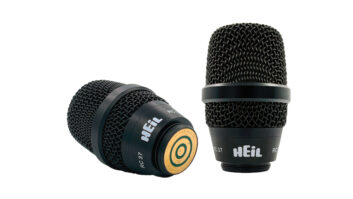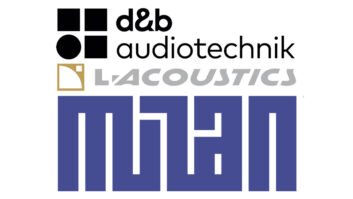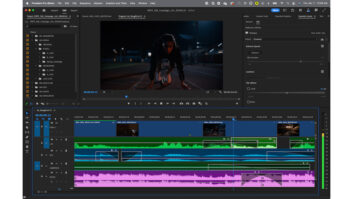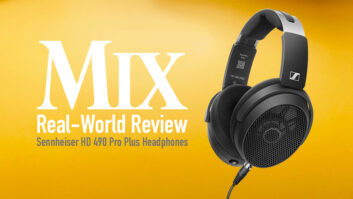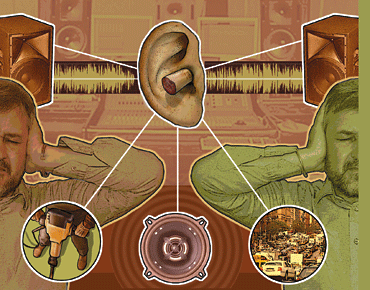

It all started with the EQ. He found himself reaching for the highs, trying to add back that sizzle his mixes seemed to be missing. At home, he started jacking up the volume on his phone, and then his iPod. During band practice, he was always asking the guys to repeat themselves; then his girlfriend began complaining that he never listened anymore. It wasn’t until his ears started ringing that he finally made an appointment with an audiologist, but by then, the damage was done. He is a young, dynamic engineer on the verge of breaking into the big time and he has profound, irreversible hearing loss. He is 28 years old.
Illustration: Tad Majewski
Know anyone with a story like this? No? Perhaps it’s because hearing loss is such a taboo issue in the recording world — the skeleton in our industry’s closet. In a work culture where people freely exchange war stories, no engineer wants to risk losing a gig because they have a notch at 6k.
Hearing damage sneaks up on you. Tape distortion and digital clipping are obvious to the ear, but hearing loss is slow and painless; by the time someone figures out there’s a problem, it’s usually too late.
It’s a vicious cycle: Those who depend on their hearing to do their job put it at a risk by doing their job, day after day. To be sure, loud music is not the worst audio event you can inflict on your ears: The relentless industrial din of construction sites and factories, or the sudden acoustic trauma of gunshots are far worse. But unlike a job foreman or the guy at the firing range, audio engineers are a sound-savvy group and have a pretty good idea of what they are getting themselves into.
So it should be a no-brainer: Engineers rely on their ears. The damage is preventable. Their hands are on the volume controls. Why isn’t anyone turning it down?
A WELL-KEPT SECRET
Kathy Peck, founder of San Francisco-based grassroots nonprofit Hearing Education Awareness for Rockers (H.E.A.R.), made it her mission to raise awareness for hearing after she experienced severe ear trauma at a single concert in the ’80s when her band, The Contractions, opened for Duran Duran at a local arena. Since then, she has worked tirelessly to educate the public about the dangers of noise exposure and provide musicians and music fans with hearing protection. She says that industry awareness was an issue from day one.
“When H.E.A.R. first started, people didn’t equate music with hearing loss,” she says. “Or you didn’t talk about it, or you were too old, or you weren’t cool.” The first high-profile musician to publicly disclose his hearing loss was Pete Townshend, who admitted in 1989 that he had sustained severe damage playing with The Who; since then, a handful of famous musicians have come forward to discuss their own impairment.
The occasional rock star aside, personal anecdotes in the recording industry are hard to come by, but the numbers don’t lie: The House Ear Institute has collected data from nearly 7,000 audio engineer hearing screenings from conventions since 1997, and results point to damage across age, gender and occupation. (See the graph titled “Is Your Job High-Risk?” on page 42.) In one of the most striking findings, all tested groups shared a characteristic “noise notch” — a distinct loss in sensitivity — in the 4 to 6kHz range. What’s more, the notch grew deeper with results taken from trade shows dedicated to live sound, suggesting higher job-specific risks.
Cognitive psychologist Laurel Fisher, House Ear’s associate director of clinical studies, says the extent of damage revealed by the survey was surprising. “For me, it shows that even in their 20s, these individuals are starting to have what someone in their 50s is beginning to experience with their hearing.”
Damaged hair cells in the ear
Image Courtesy of the House Ear Institute
Voluntary tests don’t necessarily represent a cross-section of the industry, but the real situation is potentially even more alarming. “Let’s say the most at-risk people aren’t willing or don’t want to know this information — they don’t come to the booth,” says Fisher. “So only those people in those occupations that have significant noise exposure who are actually concerned enough come get tested. We’re using them as a proxy for everybody in that business.
Microscopic images of healthy hair cells in the ear
Image Courtesy of the House Earr Institute
“There’s also a legal component,” she adds. “We found that organizations really don’t want this information out because there’s the Americans With Disabilities Act and there are OSHA safety/safe-use permits; there’s regulatory overlay that comes upon the music industry much like factories, and they don’t want class-action suits and that kind of thing.”
NO PAIN, NO PROBLEM?
The evaluation of sound levels is compromised by what audiologists call the “annoyance” factor: Your favorite song never seems too noisy, but the nails on the chalkboard appear screamingly loud; actually, they possess equal damage potential. “People can adapt psychologically to very loud sounds and it can be quite enjoyable,” says House Ear audiologist and senior research associate Andy Vermiglio. “The problem is, people can sustain damage to their cochleas even when the perception was that it wasn’t that loud.”
Vermiglio uses his own experience as a drummer as an example: “I took a docimeter — a device that logs exposure to the acoustic environment — so there’s a calibrated microphone clipped to my shoulder and I take it on a gig. I have [Pro-Mark] Hot Rods® [bundles of wooden dowels, a cross between drumsticks and brushes], and I’m playing and it ‘wasn’t that loud.’ When I took the device off and loaded the data into my PC to see what I was exposed to, I was blown away. When I was hitting the rimshots with the Hot Rods on two and four, the levels were 140dB SPL at my shoulder.”
It’s easy to assume that if it doesn’t hurt, it’s not hurting you. “That’s not true,” cautions Chris Halpin, a clinical associate in audiology at the Massachusetts Eye and Ear Infirmary and assistant professor of otology and laryngology at Harvard Medical School. “You can find an area that’s not painful that’s too much of a dose for your ear, particularly if you have a ‘tender’ ear. Most of the research, of course, has been done on very steady workplace noise-risk criteria, but it is clearly possible, over the years of working somewhere, to drive your hearing down noticeably with sounds that are loud but not painful.”
“It’s unfortunate that we can all adapt to that,” adds Vermiglio. “I played in the Navy onboard an aircraft carrier. So they did flight operations, and I was out there jamming with the Navy rock band. We were trying to play louder than the jets overhead. It was fun, but it was totally insane. I mean, what were we thinking?”
KILLER SOUNDS
Generally, sound causes hearing loss in two ways. An acoustic trauma is sudden, acute damage caused by an intense blast of noise, such as an explosion. The type of damage commonly referred to as noise-induced hearing loss is a gradual degradation in sensitivity due to chronic exposure to high SPLs, such as those in an industrial factory environment — or, potentially, a recording studio.
Because the ear is not designed for repeated exposure to extremely high sound levels (see the sidebar “Inside the Ear,” page 40), its defense mechanism is limited. A middle ear “reflex action” (a contraction of ear muscles that stiffens the system, reducing the energy transmission) can minimally protect against sudden increases in sound, but it is too slow to protect against bursts of sounds such as explosions or even heavy drum hits at close range, and is inadequate for protection in high-level music or noisy environments. Exposure to continuous loud sounds sometimes causes a temporary hearing loss (temporary threshold shift) and the ears may recover in the next day or so. However, repeated exposure to harmful sounds eventually diminishes the ability of the sensory hair cells to transmit sound by flattening or disfiguring them, or fusing them together.
Two main factors contribute to this noise-induced hearing loss: intensity of sound levels and degree of exposure. Continuous noise above 85 dBA is considered a hazard potential (140 dBA for impulses), and the general rule is, the higher the SPL, the less time you should be exposed to it. OSHA safety guidelines limit “allowable duration” to eight hours at 90 dB; safe exposure time drops in half with each increase of 5 dB. These guidelines are designed to protect against long-term exposure (versus a single exposure) and are based on steady-state noise; to some extent, one can factor in variables such as dynamic range and spectral content, but researchers seem divided over the difference in risk posed by music vs. noise.
It’s also been found that two people can be affected differently in the same environment. Research has shown a genetic predisposition, or susceptibility, to damage. “For any anecdote that you can make about an aging rock star who can’t hear, you can find someone else who stood beside him for the entire time who doesn’t seem to be having any trouble at all,” says Halpin. “And so the reason people are rightly concerned is, once the damage happens, you can’t remediate it. So it’s okay to be very cautious about this stuff, but it’s also true that not everybody will be damaged by the same sorts of exposure.”
What about the gear factor? Does high-resolution digital audio “hurt” more than analog? Is “cleaner,” distortion-free program material healthier? Do directional P.A.s and in-ear monitors provide ear immunity onstage? Are iPod earbuds sending us all straight to hearing hell? Although there’s a valid concern that improved technologies (and profileration of these devices) have made it much easier and more enjoyable to listen for long periods of time, the technologies themselves are not fundamentally altering the risk — whether we’re talking about consumer gear or pro.
“No matter how technology changes, the rules are the same,” says Vermiglio. “If you’re exposed to loud sounds over a certain period of time, the louder the sounds and the longer the length of exposure, the greater the risk of hearing loss and the greater the risk of structural damage to the cochlea.”
It’s hard to fathom anything worse for an audio engineer than dropouts in hearing. How about unwelcome, uncontrollable noise? Tinnitus — a continuous ringing, buzzing, whooshing or humming perceived when none is present — is a common symptom of noise-induced hearing loss. According to the American Tinnitus Association, more than 12 million people suffer from the condition, which can range from annoying to debilitating. There’s no cure, although research points to possible drug targets; current treatments range from behavioral therapy to suppression through external sound.
Other disorders include hyperacusis, a supersensitivity/decreased tolerance to normal sounds, and recruitment, which is characterized by extra sensitivity to dynamic fluctuations that may be accompanied by “fuzzy” hearing due to stimulation of adjacent critical bands in the cochlea.
GET TESTED
Worrying about your hearing is fruitless unless you know exactly where you stand; audiologists recommend getting a baseline evaluation immediately, especially if you don’t think you need it. “There’s no reason that anybody who works with their ears that much wouldn’t want to have a baseline audiogram,” says Halpin. “And then from there, whenever they were either on a regular schedule or when they got concerned about their ears, they get a follow-up audiogram. And they would be directly able to compare them to see if their concerns were borne out by the measurement or not.”
Most experts recommend an annual audiogram, the standard hearing test based on pure tones between 250 and 8k Hz. (OSHA’s safe-listening guidelines are based on this test.) Some research shows that additional tests can detect the earliest signs of cochlear hair cell damage. “In the field of audiology, normal hearing is generally defined as the ability to hear these tones at a very soft level,” explains Vermiglio. “So somebody comes in and takes that hearing test, and they’re hearing those tones at 25dB HL or softer, then that’s considered hearing within normal limits. While the audiogram is a very important measure of hearing ability, research has shown that the audiogram is not the most sensitive indicator of the earliest form of noise-induced damage to the cochlea.” He recommends speech-in-noise tests and evaluation of otoacoustic emissions: sounds actually generated within the inner ear (related to the amplification function of the outer hair cells). “Audiologists have found a relationship between how well a person hears speech in background noise and how well their outer hair cells are functioning when you’re looking at their otoacoustic emissions,” he explains. “You can get two groups of people with normal audiograms, and traditionally audiologists would say both people have normal amounts of hearing. One group, let’s say, has a history of exposure to really loud sounds; the other group does not. If you take a look at the otoacoustic emissions between the two groups, you’ll find reduced emissions in the group with the history of exposure to loud sounds.”
Once tested, audio engineers are tempted to compensate for losses in their hearing spectrum with signal processing, but when those frequencies are gone, there’s no bringing them back. “That’s a problem of misunderstanding,” explains Halpin. “The test result looks like an EQ that’s out of whack, but that’s not what it is; it’s dead and damaged sensory tissue that’s deep inside the hardest bone in the body, and you just can’t mess with it. And so even though it looks like you could just add back some high frequencies and be fine, it really, really doesn’t work that way.”
PROTECTION OPTIONS
How can you protect yourself on the job, short of avoiding loud sounds completely? First, take out the guesswork: Get a dB meter and find out what kinds of SPLs you’re really being exposed to throughout the day, both in and out of the studio; the results might surprise you. (I was a little surprised, for example, to find out that the hair dryer I point at my head every morning puts out 97 dB.)
Understand the psychoacoustic aspects of mixing at high volume levels. “As you know, there’s something that happens to the mix when you’re going from a low level to a really cranked level,” explains Vermiglio. “Say you’re mixing a metal band and they want to mix at loud levels. The mix is going to be different than if you had mixed at a low level because of that upward spread of excitation in the cochlea. The bass frequencies will actually mask out your perception of the high frequencies. So you have to pump high frequencies up to perceive them.”
Anything you can do to reduce total average exposure counts. “First, always heavily protect yourself against the sounds that you don’t really want to hear,” says Halpin. “If you’re hunting, shooting — go overboard with that protection.” On the job, Halpin suggests bringing levels down to the lowest reasonable dose whenever you can. “And remember that as a dose, it works like that; a little bit less can really put you out of the range of danger.” Take frequent breaks. Take advantage of the fact that some tasks, such as editing, can be performed at lower intensities and save cranking it up for the final mix. If a neighbor is mowing the lawn at the end of a long day in the studio, throw in ear protection.
House Ear Institute hearing surveys of nearly 7,000 attendees at AES, NAMM, LDI and NSCA conventions show a “noise notch” in the high end of the test spectrum, with more significant damage demonstrated at particular conventions—notably, sound reinforcement shows.
One of the best steps to protect your ears, however, is to invest in a pair of quality flat-response earplugs. Options range from off-the-shelf products to custom-fit models, and they can reduce levels by up to 20 dB or more without coloring the sound. Vermiglio says that as a musician, he finds that wearing flat-attenuation earplugs makes listening to music more enjoyable, and he can actually hear better. “The highs are crisper with the plugs in because of that effect called the upward spread of masking, or upward spread of excitation, where when the bass frequencies are really cranked, it distorts your ability to hear the highs.”
He adds that he cannot stress enough the value of wearing ear protection. “At these trade shows where we’ve conducted tests, when I see somebody in, say, their 30s or 40s who has fairly good hearing as measured by the audiogram, I ask them, ‘Well, what do you do?’ And they’ll say, ‘Oh, I play guitar in a metal band,’ or, ‘I mix really loud bands,’ or, ‘I’ve been on the road for years and years,’ and then I’ll ask them, ‘Do you wear hearing protection?’ And they’ll always say, ‘Oh, yeah, religiously. I will not mix this band unless I’m wearing my hearing protection.’ It is really, really significant the effect of hearing protection on the status of the ears. And then I’ve seen young guys, even in their early 20s, who might have a severe high-frequency loss. And I’ll say, ‘What do you do,’ and they’ll tell me their history of exposure to loud sounds, and I’ll say, ‘Do you ever wear hearing protection?’ and they’ll say, “Oh, nah. You think I should?’”
Anyone who discovers that they have hearing loss should make sure their audiologist and ENT doctor rule out medical issues that might be resolvable, from problems in the ear canal to, in some cases, issues with the central auditory system. Finally, don’t write your ears off once you’ve sustained damage. “In speaking with audio engineers and musicians, once in a while this comment will come up: ‘Oh, well my hearing is shot anyway, so I don’t need to wear hearing protection,’” says Vermiglio. “And that’s not true. You always have to wear hearing protection, even if you have sustained some loss. You want to protect against a really rapid decline of your hearing as you get older.”
“I hope people can calm that fear of finding out,” says Peck. “People feel that if they do have some damage, then they have to stop doing what they’re doing. But that’s the wrong attitude. You might have to modify what you do, but don’t feel that you have to give up. Don’t let it own you.”
LOOKING AHEAD
The field of audiology has made huge strides in recent years; advancements have ranged from experimental psychological compensation training systems to successful regeneration of cochlear hair cells in mice, but don’t count on science to find a way to reverse hearing damage during the lifespan of your career.
“I think they’ll do it, but I don’t think they’ll do it really soon,” Halpin says of the efforts to reverse hearing loss. “My own estimate is 20 years. I think the ear is one of the last ones they’ll get to because if you think of it, you can look right in the eye and see the sensory cells. You can pretty well get at the heart when you need to. But man, the ear — the ear that I’m talking about, of course, is the cochlea with the little tiny nerve receptors and hair cells — it’s much more to difficult to get at that.”
So take whatever precautions you can now to head off damage before it happens, because no amount of studio gear and no hearing aid will bring your ears — or mixes — back. Common sense is the name of the game: Reduce the level of the sounds you’re exposed to and reduce the time that you’re exposed to the sounds, and your chances of preserving your hearing are vastly improved. “The bottom line for me,” says Halpin, “is to not let any of this stop people’s work or enjoyment, but to be aware and dole out the dBs intelligently.”
Sarah Jones is Mix’s features editor.
Image Courtesy of the House Ear Institute
INSIDE THE EAR
Ears are highly sensitive mechanical systems, designed to pick up fluctuations in sound pressure at the molecular level and distinguish variations in energy over a hundred thousand-fold. They contain our smallest bones and muscles, and are among our most well-protected organs, buried deep inside the hardest bone in the body.
Sound waves are collected by the pinna and transmitted through the ear canal, where they excite the eardrum. Vibrations are then transferred from the eardrum to the ossicles, the bones of the middle ear. The middle ear acts as an impedance transformer, concentrating the force and amplifying vibrations as they are transmitted to the fluid-filled cochlea of the inner ear. Here, 20,000 sensory “hair cells,” increasing in length along the organ, vibrate at resonant frequencies as they are bent by the wave-like action in the cochlear fluid. This “spectral analysis” is then converted into electrical information and sent to the brain.
SUPPORT HEARING HEALTH
The Mix Foundation for Excellence in Audio, in partnership with the House Ear Institute and H.E.A.R., supports various programs dedicated to the advancement of hearing health — in particular, building awareness among both audio professionals and consumers about preventing hearing loss in music environments. To make a tax-deductible contribution, visit www.mixfoundation.org.

HOW LOUD IS IT?
The Mix editors are taking their dB meters everywhere they go to find out how noisy their lives really are. Send us a picture of you and your reading and we’ll add it to our collection:
Kevin Becka: Airplane cabin, 76 dB
Sarah Jones, NAMM Show, 89 dB
SPREAD THE WORD
Print this “Hearing Risk By Activity” chart and share it with your friends. (Image courtesy House Ear Institute)
HEARING HEALTH RESOURCES
Discover what hearing loss sounds like with this online simulator: www.cdc.gov/Niosh/mining/topics/hearingloss/hlsoundslike.htm
Learn more about OSHA’s Occupational Noise Exposure Guidelines:
www.osha.gov/pls/oshaweb/owadisp.show_document?p_table=standards&p_id=9735
Get more information about tinnitus from the American Tinnitus Association: www.ata.org/about_tinnitus/consumer/faq.html
For more about ear physiology, hygeine and safety, visit the House Ear Institute’s resource pages: www.hei.org/education/health/health.htm
To learn more about the Mix Foundation and make a tax-deductable contribution to hearing health and audio education, visit mixfoundation.org/hearinged.html




